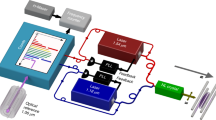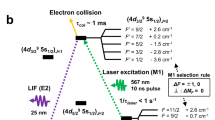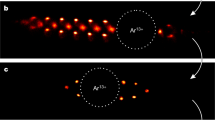Abstract
Comparison of precise predictions of the energy levels of the molecular hydrogen ion \({\rm{H}}_{2}^{+}\)—the simplest molecule—with measured vibrational transition frequencies would allow a direct determination of the proton-to-electron mass ratio and of the proton’s charge radius. Here we report vibrational laser spectroscopy of trapped and sympathetically laser-cooled \({{{{\rm{H}}}}}_{2}^{+}\), which represents a step towards this goal. We studied a first-overtone electric-quadrupole transition and measured its two hyperfine components. The determined spin-averaged vibrational transition frequency has a fractional uncertainty of 1.2 × 10−8 and is in agreement with the theoretically predicted value. We measured an analogous electric-quadrupole transition in HD+ to estimate systematic uncertainties. Here, we observed a vastly improved line quality factor compared to previous electric-quadrupole spectroscopy of molecular ions. Our work demonstrates that first-overtone electric-quadrupole transitions are suitable for precision spectroscopy of molecular ions, including \({{{{\rm{H}}}}}_{2}^{+}\), and that determining the proton-to-electron mass ratio with laser spectroscopy could become competitive with mass spectrometry using Penning traps. Furthermore, achieving precision spectroscopy of \({{{{\rm{H}}}}}_{2}^{+}\) is an essential prerequisite for a future test of combined charge, parity and time reversal symmetry based on a comparison with its antimatter counterpart.
This is a preview of subscription content, access via your institution
Access options
Access Nature and 54 other Nature Portfolio journals
Get Nature+, our best-value online-access subscription
$29.99 / 30 days
cancel any time
Subscribe to this journal
Receive 12 print issues and online access
$209.00 per year
only $17.42 per issue
Buy this article
- Purchase on Springer Link
- Instant access to full article PDF
Prices may be subject to local taxes which are calculated during checkout



Similar content being viewed by others
Data availability
Source data are provided with this paper. All other data that support the plots within this paper and other findings of this study are available from the corresponding author upon reasonable request.
Code availability
No custom code or software was used for analysing or presenting the data associated with this paper.
References
Korobov, V. I. & Karr, J.-P. Rovibrational spin-averaged transitions in the hydrogen molecular ions. Phys. Rev. A 104, 032806 (2021).
Alighanbari, S., Giri, G. S., Constantin, F. L., Korobov, V. I. & Schiller, S. Precise test of quantum electrodynamics and determination of fundamental constants with HD+ ions. Nature 581, 152–158 (2020).
Patra, S. et al. Proton-electron mass ratio from laser spectroscopy of HD+ at the part-per-trillion level. Science 369, 1238–1241 (2020).
Kortunov, I. V. et al. Proton-electron mass ratio by high-resolution optical spectroscopy of ion ensembles in the resolved-carrier regime. Nat. Phys. 17, 569–573 (2021).
Alighanbari, S., Kortunov, I. V., Giri, G. S. & Schiller, S. Test of charged baryon interaction with high-resolution vibrational spectroscopy of molecular hydrogen ions. Nat. Phys. 19, 1263–1269 (2023).
Schiller, S. Precision spectroscopy of molecular hydrogen ions: an introduction. Contemp. Phys. 63, 247–279 (2022).
Karr, J.-P. & Koelemeij, J. C. J. Extraction of spin-averaged rovibrational transition frequencies in HD+ for the determination of fundamental constants. Mol. Phys. 121, e2216081 (2023).
Bates, D. R. & Poots, G. Properties of the hydrogen molecular ion I: quadrupole transitions in the ground electronic state and dipole transitions of the isotopic ions. Proc. Phys. Soc. Sect. A 66, 784–792 (1953).
Schiller, S. & Korobov, V. Test of time-dependence of the electron and nuclear masses with ultracold molecules. Phys. Rev. A 71, 032505 (2005).
Karr, J.-P. et al. Vibrational spectroscopy of \({{{{\rm{H}}}}}_{2}^{+}\): hyperfine structure of two-photon transitions. Phys. Rev. A 77, 063410 (2008).
Korobov, V. I., Danev, P., Bakalov, D. & Schiller, S. Laser-stimulated electric quadrupole transitions in the molecular hydrogen ion \(\mathrm{H}_{2}^{+}\). Phys. Rev. A 97, 032505 (2018).
Danev, P., Bakalov, D., Korobov, V. I. & Schiller, S. Hyperfine structure and electric quadrupole transitions in the deuterium molecular ion. Phys. Rev. A 103, 012805 (2021).
Korobov, V. I. & Bakalov, D. Forbidden ortho–para electric dipole transitions in the \({{{{\rm{H}}}}}_{2}^{+}\) ion. Phys. Rev. A 107, 022812 (2023).
Burrau, Ø. Berechnung des Energiewertes des Wasserstoffmolekel-Ions (\(\mathrm{H}_{2}^{+}\)) im Normalzustand. Die Naturwiss. I., 16–17 (1927).
Teller, E. Über das Wasserstoffmolekülion. Z. Phys. 61, 458–480 (1930).
Carrington, A. et al. Microwave electronic spectroscopy, electric field dissociation and photofragmentation of the \(\mathrm{H}_{2}^{+}\) ion. J. Chem. Soc. Faraday Trans. 89, 603–614 (1993).
Carrington, A., Leach, C. A. & Viant, M. R. Nuclear hyperfine structure in the electronic millimetre wave spectrum of \(\mathrm{H}_{2}^{+}\). Chem. Phys. Lett. 206, 77–82 (1993).
Critchley, A. D. J., Hughes, A. N. & McNab, I. R. Direct measurement of a pure rotation transition in \(\mathrm{H}_{2}^{+}\). Phys. Rev. Lett. 86, 1725–1728 (2001).
Arcuni, P. W., Fu, Z. W. & Lundeen, S. R. Energy difference between the (ν = 0, R = 1) and the (ν = 0, R = 3) states of \({{{{\rm{H}}}}}_{2}^{+}\), measured with interseries microwave spectroscopy of H2 Rydberg states. Phys. Rev. A 42, 6950–6953 (1990).
Haase, C., Beyer, M., Jungen, C. & Merkt, F. The fundamental rotational interval of para-\(\mathrm{H}_{2}^{+}\) by MQDT-assisted Rydberg spectroscopy of H2. J. Chem. Phys. 142, 064310 (2015).
Fink, D. J. & Myers, E. G. Deuteron-to-proton mass ratio from simultaneous measurement of the cyclotron frequencies of \(\mathrm{H}_{2}^{+}\) and D+. Phys. Rev. Lett. 127, 243001 (2021).
Germann, M., Tong, X. & Willitsch, S. Observation of dipole-forbidden transitions in sympathetically cooled, state-selected, homonuclear diatomic molecular ions. Nat. Phys. 10, 820–824 (2014).
Fleurbaey, H., Koroleva, A. O., Kassi, S. & Campargue, A. The high-accuracy spectroscopy of H2 rovibrational transitions in the (2-0) band near 1.2 μm. Phys. Chem. Chem. Phys. 25, 14749–14756 (2023).
Cozijn, F. M. J., Diouf, M. L. & Ubachs, W. Lamb dip of a quadrupole transition in H2. Phys. Rev. Lett. 131, 073001 (2023).
Komasa, J. Energy levels of the hydrogen molecule from relativistic nonadiabatic calculations. In Proc. International Conference on Precision Physics and Fundamental Physical Constants (FFK) (eds Widmann, E. & Karshenboim, S.) Tu-4 (Stefan Meyer Institute for Subatomic Physics, 2023); indico.cern.ch/event/1164804/
Jefferts, K. B. Hyperfine structure in the molecular ion \(\mathrm{H}_{2}^{+}\). Phys. Rev. Lett. 23, 1476–1478 (1969).
Somerville, W. B. A revised radio-frequency spectrum for \(\mathrm{H}_{2}^{+}\). Mon. Not. R. Astron. Soc. 147, 201–205 (1970).
Kalaghan, P. & Dalgarno, A. Hyperfine structure of the molecular ion \({{{{{\rm{H}}}}}_{2}}^{+}\). Phys. Lett. A 38, 485–486 (1972).
McEachran, R., Veenstra, C. & Cohen, M. Hyperfine structure in the hydrogen molecular ion. Chem. Phys. Lett. 59, 275–280 (1978).
Babb, J. F. & Dalgarno, A. Electron-nuclear coupling in the hyperfine structure of the hydrogen molecular ion. Phys. Rev. Lett. 66, 880–882 (1991).
Babb, J. F. & Dalgarno, A. Spin coupling constants and hyperfine transition frequencies for the hydrogen molecular ion. Phys. Rev. A 46, R5317–R5319 (1992).
Haidar, M., Korobov, V. I., Hilico, L. & Karr, J.-P. Higher-order corrections to spin–orbit and spin–spin tensor interactions in hydrogen molecular ions: theory and application to \({{{{\rm{H}}}}}_{2}^{+}\). Phys. Rev. A 106, 022816 (2022).
Blythe, P., Roth, B., Fröhlich, U., Wenz, H. & Schiller, S. Production of ultracold trapped molecular hydrogen ions. Phys. Rev. Lett. 95, 183002 (2005).
Yang, W., Alheit, R. & Werth, G. Vibrational population of \(\mathrm{H}_{2}^{+}\) after electroionization of thermal H2. Z. Phys. D: At. Mol. Clusters 28, 87–88 (1993).
Schneider, T., Roth, B., Duncker, H., Ernsting, I. & Schiller, S. All-optical preparation of molecular ions in the rovibrational ground state. Nat. Phys. 6, 275–278 (2010).
Leung, K. H. et al. Terahertz vibrational molecular clock with systematic uncertainty at the 10−14 level. Phys. Rev. X 13, 011047 (2023).
Amitay, Z., Zajfman, D. & Forck, P. Rotational and vibrational lifetime of isotopically asymmetrized homonuclear diatomic molecular ions. Phys. Rev. A 50, 2304–2308 (1994).
Bakalov, D., Korobov, V. & Schiller, S. Magnetic field effects in the transitions of the HD+ molecular ion and precision spectroscopy. J. Phys. B: At. Mol. Opt. Phys. 44, 025003 (2011).
Karr, J.-P., Korobov, V. I. & Hilico, L. Vibrational spectroscopy of \(\mathrm{H}_{2}^{+}\): Precise evaluation of the Zeeman effect. Phys. Rev. A 77, 062507 (2008).
Herzberg, G. & Jungen, C. Rydberg series and ionization potential of the H2 molecule. J. Mol. Spectrosc. 41, 425–486 (1972).
Menasian, S. C. High Resolution Study of the (F, F2) = (3/2, 1/2) → (1/2, 1/2) HFS Transitions in Stored \({{{{\rm{H}}}}}_{2}^{+}\) Molecular Ions. PhD thesis, Univ. of Washington (1973).
Schiller, S., Bakalov, D. & Korobov, V. I. Simplest molecules as candidates for precise optical clocks. Phys. Rev. Lett. 113, 023004 (2014).
Karr, J.-P. \({{{{\rm{H}}}}}_{2}^{+}\) and HD+: candidates for a molecular clock. J. Mol. Spectrosc. 300, 37 – 43 (2014).
Karr, J.-P. et al. Hydrogen molecular ions: new schemes for metrology and fundamental physics tests. J. Phys.: Conf. Ser. 723, 012048 (2016).
Schiller, S. & Korobov, V. I. Canceling spin-dependent contributions and systematic shifts in precision spectroscopy of molecular hydrogen ions. Phys. Rev. A 98, 022511 (2018).
Hori, M. et al. Buffer-gas cooling of antiprotonic helium to 1.5 to 1.7 K, and antiproton-to-electron mass ratio. Science 354, 610–614 (2016).
Borchert, M. J. et al. A 16-parts-per-trillion measurement of the antiproton-to-proton charge-mass ratio. Nature 601, 53–57 (2022).
Dehmelt, H. Economic synthesis and precision spectroscopy of anti-molecular hydrogen ions in Paul trap. Phys. Scr. T59, 423 (1995).
Myers, E. G. CPT tests with the antihydrogen molecular ion. Phys. Rev. A 98, 010101 (2018).
Zammit, M. C. et al. Laser-driven production of the antihydrogen molecular ion. Phys. Rev. A 100, 042709 (2019).
Kajita, M., Gopakumar, G., Abe, M., Hada, M. & Keller, M. Test of mp/me changes using vibrational transitions in \({{{{\rm{N}}}}}_{2}^{+}\). Phys. Rev. A 89, 032509 (2014).
Hanneke, D., Carollo, R. A. & Lane, D. A. High sensitivity to variation in the proton-to-electron mass ratio in \({{{{{\rm{O}}}}}_{2}}^{+}\). Phys. Rev. A 94, 050101 (2016).
Wolf, F. et al. Non-destructive state detection for quantum logic spectroscopy of molecular ions. Nature 530, 457–460 (2016).
Egl, A. et al. Application of the continuous Stern–Gerlach effect for laser spectroscopy of the 40Ar13+ fine structure in a Penning trap. Phys. Rev. Lett. 123, 123001 (2019).
Schmidt, J. et al. Trapping, cooling, and photodissociation analysis of state-selected \(\mathrm{H}_{2}^{+}\) ions produced by (3 + 1) multiphoton ionization. Phys. Rev. Appl. 14, 024053 (2020).
König, C. M. et al. Hyperfine spectroscopy of single molecular hydrogen ions in a Penning trap at ALPHATRAP. In Proc. International Conference on Precision Physics of Simple Atomic Systems (eds Pachucki, K., Karshenboim, S. & Tong, X.) 14 (PSAS, 2022); psas.fuw.edu.pl/program/
Schwegler, N. et al. Trapping and ground-state cooling of a single \({{{{\rm{H}}}}}_{2}^{+}\). Phys. Rev. Lett. 131, 133003 (2023).
Dunn, G. H. Photodissociation of \(\mathrm{H}_{2}^{+}\) and \(\mathrm{D}_{2}^{+}\): Theory. Phys. Rev. 172, 1-7 (1968).
Olivares Pilón, H. & Baye, D. Quadrupole transitions in the bound rotational-vibrational spectrum of the hydrogen molecular ion. J. Phys. B: At. Mol. Opt. Phys. 45, 065101 (2012).
Bekbaev, A. K., Aznabayev, D. T. & Korobov, I. V. Quadrupole transitions of the hydrogen molecular ion HD+. In Proc. International Conference on Precision Physics and Fundamental Physical Constants Vol. 9 (eds Horváth, D., Karshenboim, S. & Siklér, F.) 058 (2019).
Bakalov, D. & Schiller, S. Static Stark effect in the molecular ion HD+. Hyperfine Interact. 210, 25–31 (2012).
Shen, J., Borodin, A. & Schiller, S. A simple method for characterization of the magnetic field in an ion trap using Be+ ions. Eur. Phys. J. D 68, 359 (2014).
Collopy, A. L., Schmidt, J., Leibfried, D., Leibrandt, D. R. & Chou, C.-W. Effects of an oscillating electric field on and dipole moment measurement of a single molecular ion. Phys. Rev. Lett. 130, 223201 (2023).
Hegstrom, R. A. g factors and related magnetic properties of molecules. Formulation of theory and calculations for \(\mathrm{H}_{2}^{+}\), HD+, and \(\mathrm{D}_{2}^{+}\). Phys. Rev. A 19, 17–30 (1979).
Karr, J.-P. Leading-order relativistic corrections to the g factor of \(\mathrm{H}_{2}^{+}\). Phys. Rev. A 104, 032822 (2021).
Schiller, S., Bakalov, D., Bekbaev, A. K. & Korobov, V. I. Static and dynamic polarizability and the Stark and blackbody-radiation frequency shifts of the molecular hydrogen ions \({{{{\rm{H}}}}}_{2}^{+}\), HD+, and \({{{{\rm{H}}}}}_{2}^{+}\). Phys. Rev. A 89, 052521 (2014).
Korobov, V. I., Hilico, L. & Karr, J.-P. Fundamental transitions and ionization energies of the hydrogen molecular ions with few ppt uncertainty. Phys. Rev. Lett. 118, 233001 (2017).
Acknowledgements
We are indebted to V. I. Korobov for putting at our disposal his codes for the computation of the \({{{{\rm{H}}}}}_{2}^{+}\) properties and for many important communications on the properties of MHI. We are grateful to S. Schlemmer (Universität zu Köln) for generously providing para-H2 gas. G. S. Giri contributed to early tests of the spectroscopy. The assistance of U. Rosowski in the maintenance of the H maser and data analysis has been important. C. Wellers and V. Vogt contributed in obtaining and characterizing the OPO. M. G. Hansen and I. V. Kortunov are acknowledged for their help on setting up the locking and metrology scheme of the OPO. We also thank E. Wiens for support in the optical frequency measurements. We thank S. Sturm, F. Heiße, C. König and S. Ulmer for discussions about the CPT tests. This work has received funding from the European Research Council under the European Union’s Horizon 2020 research and innovation programme (Grant Agreement No. 786306, PREMOL (S.S.)) and from both the German Research Foundation and the state of North-Rhine-Westphalia (Grant Nos. INST-208/774-1 FUGG (S.S.) and INST-208/796-1 FUGG (S.S.)).
Author information
Authors and Affiliations
Contributions
M.R.S. and S.A. performed the experiments and analysed the data. M.R.S. developed and characterized the spectroscopy laser system. S.A. maintained the apparatus. S.S. conceived the experiment, supervised the project and performed analyses. All authors contributed to writing the manuscript and reviewing the data.
Corresponding author
Ethics declarations
Competing interests
The authors declare no competing interests.
Peer review
Peer review information
Nature Physics thanks Shui-Ming Hu, Krzysztof Pachucki and Xin Tong for their contribution to the peer review of this work.
Additional information
Publisher’s note Springer Nature remains neutral with regard to jurisdictional claims in published maps and institutional affiliations.
Extended data
Extended Data Fig. 1 The \({{{{\rm{H}}}}}_{2}^{+}\) spectroscopy cycle.
The black trace is the Be+ fluorescence detected by a photomultiplier tube in mega counts per second (Mcps). During the depletion of the excited state population (see Methods, section 1.a), the fluorescence is multiplied by 0.5 for illustration purposes. The red ovals indicate the radial secular excitation resonance of the trapped \({{{{\rm{H}}}}}_{2}^{+}\) and \({{{{\rm{H}}}}}_{3}^{+}\) ions. The actual spectroscopy signal, that is the reduction of the number of trapped \({{{{\rm{H}}}}}_{2}^{+}\) ions by the REMPD process, is highlighted in the top (black) signal by the red dashed lines and red arrows. The interleaved shuttering during the REMPD is shown simplified with only 10 repetitions. In actuality, there are 310 repetitions of duration ≃ 62 ms each. Each consists of two 30 ms and two 1 ms intervals. During the 30 ms intervals, either the 2.4 μm wave or the 405 nm wave is sent to the ions. The 1 ms intervals act as a buffers in-between. The cycle for measuring the background is analogous, except that the 2.4 μm wave is off during the whole cycle. During the exposure to the REMPD lasers, the magnetic field was ∣B∣≤0.2 μT, while at all other times a magnetic field Bcooling for the purpose of Doppler-cooling was applied. The values and status of each parameter are displayed on the right-hand vertical axis.
Source data
Source Data for Fig. 2
Source data for the data points shown in Fig. 2, including errors.
Source Data for Fig. 3
Source data for the data points shown in Fig. 3, including errors.
Rights and permissions
Springer Nature or its licensor (e.g. a society or other partner) holds exclusive rights to this article under a publishing agreement with the author(s) or other rightsholder(s); author self-archiving of the accepted manuscript version of this article is solely governed by the terms of such publishing agreement and applicable law.
About this article
Cite this article
Schenkel, M.R., Alighanbari, S. & Schiller, S. Laser spectroscopy of a rovibrational transition in the molecular hydrogen ion \({\mathbf{H}}_{\mathbf{2}}^{\mathbf{+}}\). Nat. Phys. 20, 383–388 (2024). https://doi.org/10.1038/s41567-023-02320-z
Received:
Accepted:
Published:
Issue Date:
DOI: https://doi.org/10.1038/s41567-023-02320-z
This article is cited by
-
Precisely simple
Nature Physics (2024)



